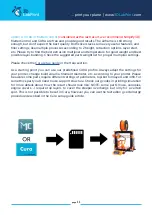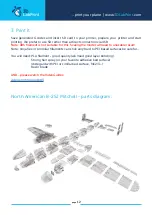
page
4
... print your plane | www.
3DLabPrint
.com
North American B-25J Mitchell
,
History
The North American B-25 Mitchell is a medium bomber that was introduced in 1941 and
named in honor of Major General William „Billy“ Mitchell, a pioneer of U.S. military aviation.
Used by many Allied air forces, the B-25 served in every theater of World War II, and after the
war ended, many remained in service, operating across four decades. Produced in numerous
variants, nearly 10,000 B-25s were built. These included a few limited models such as the
F-10 reconnaissance aircraft, the AT-24 crew trainers, and the United States Marine Corps‘
PBJ-1 patrol bomber.
The Air Corps issued a circular (number 38-385) in March 1938 describing the performance
they required from the next bombers — a payload of 1,200 lb (540 kg) with a range of 1,200 mi
(1,900 km) at more than 200 mph (320 km/h). Those performance specifications led NAA[4]
to submit their NA-40 design. The NA-40 had benefited from the North American XB-21 (NA-
39) of 1936, which was the company‘s partly successful design for an earlier medium bomber
that had been initially accepted and ordered, but then cancelled. However, the company‘s
experience from the XB-21 contributed to the design and development of the NA-40. The
single NA-40 built flew first at the end of January 1939. It went through several modifications
to correct problems. These improvements included fitting 1,600 hp (1,193 kW) Wright R-2600
„Twin Cyclone“ radial engines, in March 1939, which solved the lack of power.
In March 1939, North American delivered the substantially redesigned and improved NA-
40 (as NA-40B) to the United States Army Air Corps for evaluation. It was in competition
with other manufacturers‘ designs (Douglas 7B, Stearman X-100, and the Martin Model 167F)
[5] but failed to win orders. The aircraft was originally intended to be an attack bomber for
export to the United Kingdom and France, both of which had a pressing requirement for
such aircraft in the early stages of World War II. However, the French had already opted for
a revised Douglas 7B (as the DB-7). Unfortunately, the NA-40B was destroyed in a crash on
11 April 1939 while undergoing testing. Although the crash was not considered due to a fault
with the aircraft design, the Army ordered the DB-7 as the A-20.
The Air Corps issued a specification for a medium bomber in March 1939 that was capable of
carrying a payload of 2,400 lb (1,100 kg) over 1,200 mi (1,900 km) at 300 mph (480 km/h) NAA
used the NA-40B design to develop the NA-62, which competed for the medium bomber
contract. No YB-25 was available for prototype service tests. In September 1939, the Air Corps
ordered the NA-62 into production as the B-25, along with the other new Air Corps medium
bomber, the Martin B-26 Marauder „off the drawing board“.
Interior of huge aircraft factory where rows of bombers are being assembled
North American B-25 Mitchell production in Kansas City in 1942





































